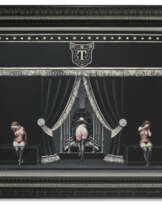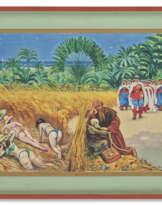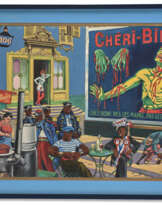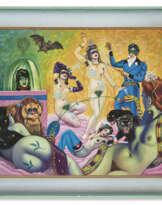ID 1304151
Lot 57 | Clovis Trouille (1889-1975)
Estimate value
€ 70 000 – 120 000
Dolmancé et ses fantômes de luxure ou Dolmancé et les fantômes de luxure ou Adoration du bouc « Dolmancé » ou Dolmancé en son château de La Coste 1959 ou « Luxure » ou « Luxure ou les rêveries du Marquis de Sade »
signé 'Clovis Trouille' (en bas à droite); signé et inscrit 'Clovis Trouille 57 Avenue Mathurin Moreau Paris 19è Dolmancé et ses fantômes de luxure' (au revers); signé et inscrit 'Clovis Trouille 57 Avenue Mathurin Moreau Paris 19è Dolmancé et ses fantômes de luxure' (sur le châssis)
huile sur toile dans le cadre de l'artiste
Image: 50.5 x 61.2 cm.
Cadre de l'artiste: 62.6 x 73.5 x 5.2 cm.
Peint entre 1958 et 1965
signed 'Clovis Trouille' (lower right); signed and inscribed 'Clovis Trouille 57 Avenue Mathurin Moreau Paris 19è Dolmancé et ses fantômes de luxure' (on the reverse); signed and inscribed 'Clovis Trouille 57 Avenue Mathurin Moreau Paris 19è Dolmancé et ses fantômes de luxure' (on the stretcher)
oil on canvas in the artist's frame
Image: 19 7/8 x 24 1/8 in.
Artist's frame: 24 5/8 x 29 x 2 in.
Painted between 1958 and 1965
Provenance
Atelier de l'artiste.
Puis par succession aux propriétaires actuels.
Literature
O. Volta, Le Vampire, Paris, 1962, p. 113 (illustré).
J.-J. Pauvert, (éd.), Dictionnaire de Sexologie, Sexologia-Lexikon, Paris, 1962, p. 536 (illustré).
J.-M. Campagne, Clovis Trouille, Ivry, 1969, p. 64 (illustré en couleurs).
R. Charmet et C. Trouille, Clovis Trouille, Paris, 1972, p. 67 (illustré en couleurs, p. 66-67).
D.A.F. de Sade, La Philosophie dans le boudoir, Paris, 1979 (illustré en couleurs en couverture).
C. Prévost, Parcours à travers l'œuvre de Clovis Trouille, Arles, 2003, p. 220 (illustré en couleurs; détails illustrés en couleurs, p. 221 et p. 251).
Exhibited
Paris, Galerie Daniel Cordier, Exposition « EROS », VIIIe Exposition InteRnatiOnale du Surréalisme, 1959-1960 (illustré).
Paris, Galerie Raymond Cordier, Clovis Trouille, mars 1963, no. 5.
Zurich, Kunsthaus, Sade/Surreal, novembre 2001-mars 2002, p. 95 (illustré en couleurs).
Paris, Musée des Arts d’Afrique et d’Océanie, Exposition Clovis Trouille, octobre 1999-janvier 2000 (sans catalogue).
Ostende, Museum voor Moderne Kunst, Clovis Trouille, mars-novembre 2002, no. 51.
Amiens, Musée de Picardie, Clovis Trouille, Un peintre libre et iconoclaste, avril-août 2007, p. 21 (illustré en couleurs).
L'Isle-Adam, Musée d’Art et d’Histoire Louis-Senlecq; Charleville-Mézières, Musée Arthur-Rimbaud et Laval, Musée du Vieux-Château, Voyous, voyants, voyeurs, Autour de Clovis Trouille, novembre 2009-janvier 2011, p. 9, no. 1 (illustré en couleurs).
Further details
Exécutée en 1963, cette huile sur toile surprenante donne à voir quatre personnages dans un décor foisonnant de détails et de couleurs. Rassemblant de manière apparemment fortuite des éléments aussi variés que des instruments de musique, un crâne ou encore des bouquetins, Luxure revêt une dimension onirique aux forts accents surréalistes, parfaitement représentative du style que Trouille cultive à la fin des années 1960. La juxtaposition du bleu turquoise à des nuances plus sombres de rouge ou de vert apporte une hardiesse et une grande vivacité, emblématiques, elles aussi, des œuvres de cette période. On y retrouve toute l'audace d'un artiste qui considère Delacroix et Gauguin « comme des coloristes timides » et qui ne fait guère dans la modération, ni dans le choix de ses motifs, ni dans son rapport à la couleur.
Les poitrines et postérieurs saillants des figures féminines, auxquels viennent s'ajouter les chaînes et le fouet du premier plan, confèrent à cette œuvre une charge érotique évidente, très incisive, propre à heurter les mœurs de l'époque. Or ces éléments clés du répertoire de Trouille reflètent avant tout l'essence-même d'une démarche plastique fondée sur une imagination débordante et l'expression de désirs intimes hantés, comme il l'admet lui-même, par leurs « excès et leur théâtralité ». C'est précisément cette vision très personnelle, associée à une méthode de travail de « peintre du dimanche », qui distingue Trouille de la plupart des artistes du XXe siècle, lui permettant de créer des œuvres d'une grande expressivité et d'une liberté de ton hors du commun.
Avec ses accessoires fétichistes (menottes, chaînes, fouets...) et ses nus féminins traités avec une impudence assumée, Luxure s'inscrit parmi les œuvres les plus licencieuses et les plus percutantes de l'artiste. Elle traduit aussi pleinement les opinions de Trouille, qui se définit comme anarchiste et méprise ouvertement les valeurs de la haute société. Luxure est d'ailleurs l'une des deux œuvres dans lesquelles Trouille fait référence au Marquis de Sade ; l'autre étant Justine, tableau de 1937 inspiré du roman éponyme de 1791. Si le personnage de Sade n'est pas représenté dans Justine, on l'aperçoit ici au premier plan, fouet à la main, l'œil rivé sur la femme enchaînée au centre de la toile, dépeint avec l'esprit satirique et le sarcasme que Trouille réservait à ses œuvres les plus engagées.
Luxure réunit les ingrédients fondamentaux de l'art de Trouille, révélant les convictions socio-politiques profondes d'un artiste qui rejetait viscéralement « la société bourgeoise, l’imposture de sa religion, la morale de ses curés, son patrocularisme » et qui rêvait, au fond, d'« une société sans frontières ».
Featuring four human figures amongst a crowded composition, Luxure is a striking oil on canvas work painted in 1963. The inclusion of various seemingly unrelated elements like musical instruments, a human skull and ibexes plunge the artwork in a surrealist and dreamlike realm, emblematic of Trouille’s style of the late 1960s. The use of turquoise blue, juxtaposed with darker red and green tones, creates an extremely vivid and unrestricted feel to this work, representative of Trouille’s practice during this period. The artist was quoted stating that ‘Delacroix and Gauguin appear to be shy colorists’, further solidifying this artistic theory and wider approach to colour usage.
The exposed breasts and backsides of the female figures alongside the whip and chain in the foreground instantly endow this work with a strong eroticism, which would have shocked viewers at the time. However, these are key elements to understanding Trouille’s artistic approach. He was known to use his imagination combined with personal desires which he quotes were haunted by their ‘excess and theatricality’. Moreover, this philosophy paired with his approach to artistic production as a ‘peintre du dimanche’ (‘Sunday painter’) was truly what drew him apart from most artists of the 20th century and allowed him to create free and expressive artworks.
Luxure also bears the hallmarks of Trouille’s most crude and striking artworks. The revealing and honest nature of his depiction of the female nude combined with several kink elements like whips and handcuffs confirm this affirmation. This painting is also the perfect embodiment of the artist’s anarchist beliefs and strong rejection of upper bourgeois society. It is one of two works depicting the Marquis of Sade, along with Justine from 1937 which is based on de Sade’s novel bearing the same title, Justine, from 1791. Whilst Justine does not depict the nobleman, Luxure is the only work portraying the Marquis himself. As in many of these socially charged paintings, Trouille has chosen a satirical and sarcastic representation as seen in the way in which he illustrates the marquis holding a whip, glaring at the chained central figure’s backside
| Artist: | Clovis Trouille (1889 - 1975) |
|---|---|
| Applied technique: | Oil on canvas |
| Auction house category: | Paintings, Watercolors, Drawings, Paintings |
| Artist: | Clovis Trouille (1889 - 1975) |
|---|---|
| Applied technique: | Oil on canvas |
| Auction house category: | Paintings, Watercolors, Drawings, Paintings |
| Address of auction |
CHRISTIE'S 8 King Street, St. James's SW1Y 6QT London United Kingdom | |
|---|---|---|
| Preview |
| |
| Phone | +44 (0)20 7839 9060 | |
| Buyer Premium | see on Website | |
| Conditions of purchase | Conditions of purchase |














